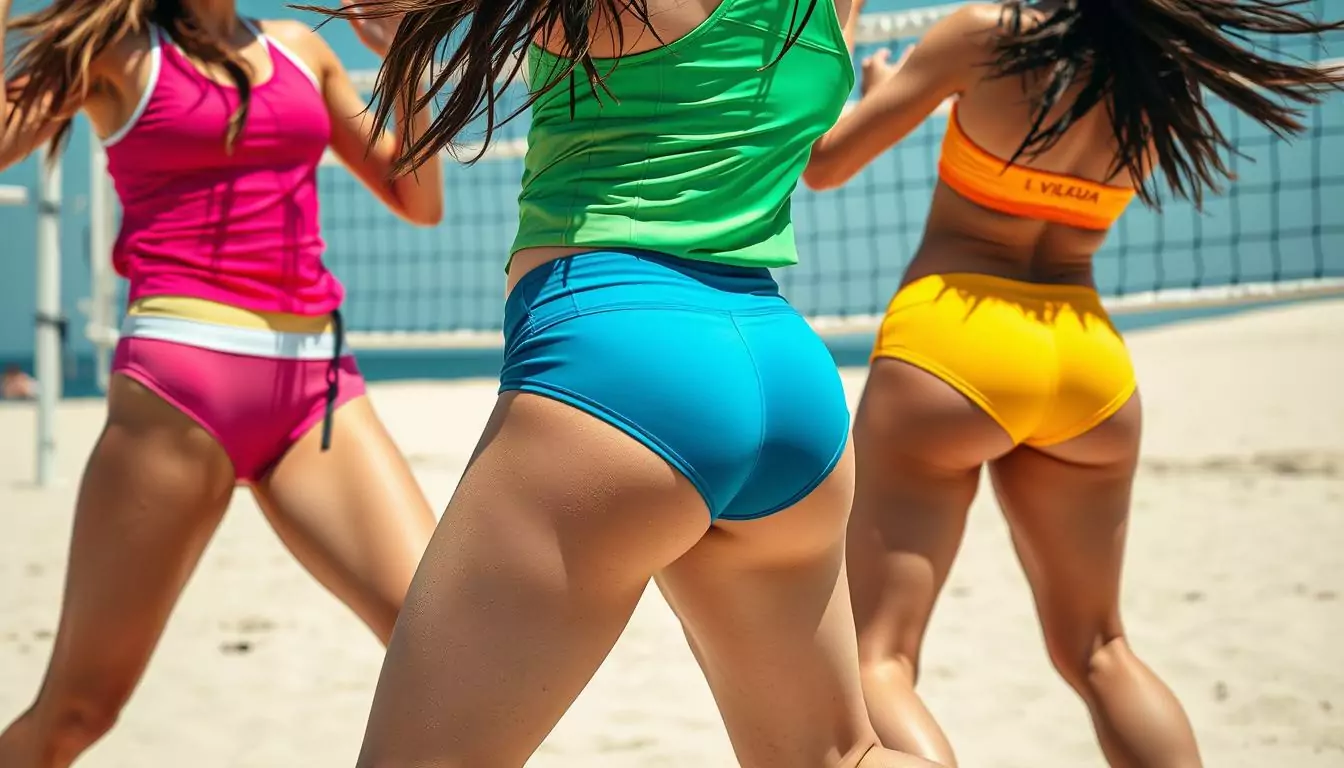As I stepped onto the volleyball court, the energy was palpable. The players, clad in their signature tight spandex shorts, were warming up with focused determination. It was a sight I had witnessed countless times, yet the reasons behind this iconic volleyball uniform never ceased to fascinate me.
For years, women volleyball players have donned these form-fitting shorts, and the story behind this sartorial choice is a fascinating one. More than just a fashion statement, these tight shorts serve practical purposes that enhance the players’ performance and comfort on the court.
Key Takeaways
- Tight spandex shorts provide maximum mobility and flexibility for volleyball players
- The snug fit helps wick away sweat and prevent chafing during intense gameplay
- Volleyball uniform designs have evolved over time, but tight shorts remain a staple
- Spandex shorts offer a sleek, athletic look that boosts player confidence and brand image
- The popularity of tight shorts highlights their importance in women’s volleyball culture and tradition
History of Women’s Volleyball Uniforms
The evolution of women’s volleyball uniforms has been a fascinating journey, reflecting the sport’s growing popularity and the changing fashion trends over the decades. In the 1970s, players typically donned basketball-style shorts, which transitioned to a more fitted mid-thigh style in the early 1980s. By the mid-1980s, the iconic “bun hugger” shorts, featuring a high-cut design, became the signature look for many volleyball teams.
Today, the current trend in women’s volleyball uniforms features inseams of 2 to 4 inches, striking a balance between modesty and functionality. This style has become increasingly popular, as players seek apparel that not only enhances their athletic look but also provides the necessary freedom of movement and comfort required for the sport.
Evolution of Uniform Design
The design of women’s volleyball uniforms has undergone significant changes over the years, driven by a combination of factors, including improved performance, changing fashion trends, and the growth of the volleyball fashion industry. These transformations have not only altered the aesthetic appeal of the sport but have also influenced the way players approach their athletic look and the overall sports apparel landscape.
Influential Factors in Uniform Choices
The choices made in designing women’s volleyball uniforms have been shaped by a variety of factors, including the desire for enhanced performance, the evolution of sports apparel technology, and the growing emphasis on the sport’s visual appeal. As the game has gained more attention and recognition, the role of uniform design has become increasingly crucial in shaping the overall athletic look and fan experience.
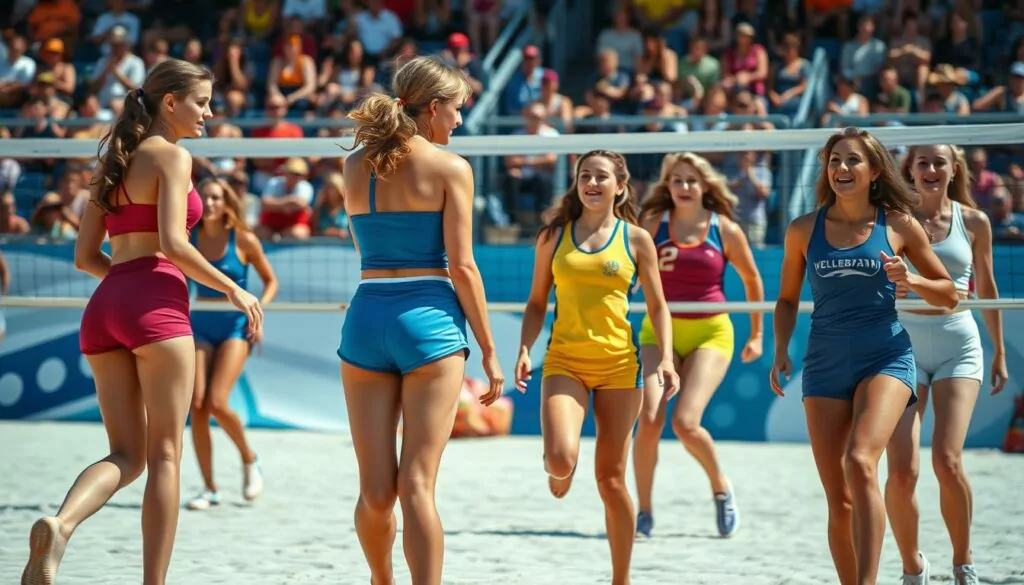
Purpose of Tight Shorts in Volleyball
Volleyball is a dynamic sport that requires players to move quickly and with precision. The tight shorts worn by female volleyball players serve a vital purpose in enhancing their performance and maximizing comfort on the court.
Enhancing Performance
Spandex shorts are the preferred choice for volleyball players as they provide an unparalleled range of motion. The stretchy, form-fitting fabric allows for unrestricted movements, enabling players to execute jumps, dives, and lateral shuffles with ease. This flexibility of movement is crucial for the sport’s fast-paced nature.
Moreover, the snug fit of these shorts ensures they don’t interfere with play or get caught in the net, minimizing distractions and allowing players to focus on the game.
Maximizing Comfort
Tight volleyball shorts also offer valuable muscle support, potentially reducing fatigue and the risk of strains or pulls during intense matches. The form-fitting design helps to keep muscles in place, providing a level of compression that can enhance endurance and performance.
In addition, the breathable and moisture-wicking properties of performance clothing fabrics used in these shorts help to keep players cool and dry, further enhancing their comfort and ability to perform at their best.
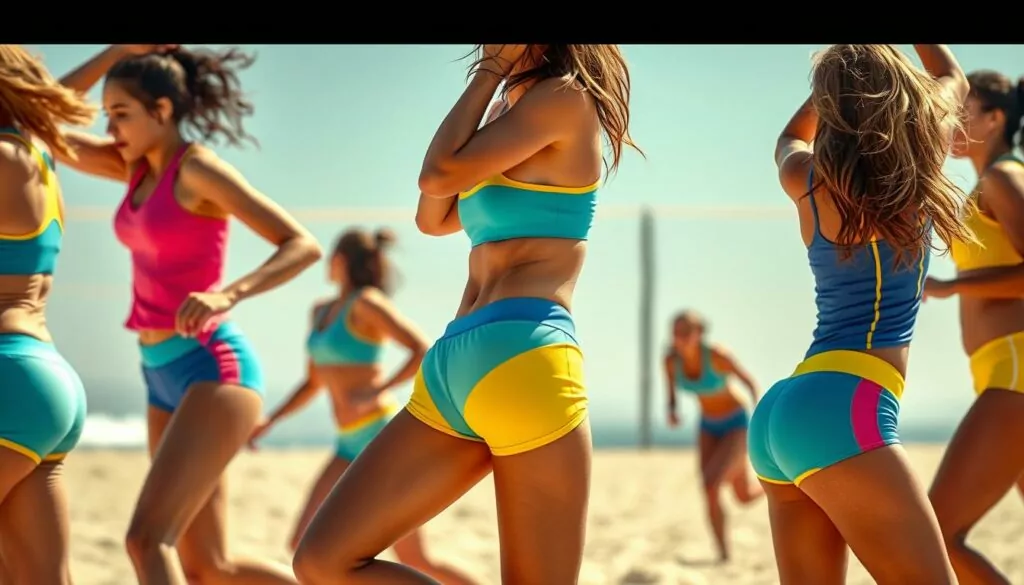
“Tight shorts are essential for volleyball players to achieve maximum flexibility and mobility on the court. The snug fit and stretchy fabric allow for unrestricted movements, which is crucial for this fast-paced sport.”
While the tight, revealing nature of women’s volleyball shorts may raise some societal concerns, the primary focus is on providing players with the necessary equipment to excel in their sport. The tight shorts are designed to enhance performance and comfort, ultimately enabling female athletes to compete at the highest level.
Material and Fabric Technology
When it comes to athletic wear, the materials and fabric technology used in volleyball uniforms and clothing play a crucial role in enhancing the performance and comfort of players. Volleyball athletes, particularly women, require apparel that is not only stylish but also highly functional, catering to the demands of their sport.
Breathability and Moisture-Wicking
Volleyball players are known for their intense physical activity, leading to significant perspiration during matches. To combat this, volleyball-specific fabrics are engineered with advanced moisture-wicking properties. These breathable materials effectively draw sweat away from the body, keeping players dry and comfortable throughout the game. This helps to reduce the risk of chafing and discomfort, allowing athletes to focus on their performance.
Stretch and Flexibility
The dynamic nature of volleyball requires a wide range of motion and unhindered movement. Volleyball shorts and other apparel are designed with stretchy, flexible fabrics that provide ample give and freedom of movement. This allows players to execute their skills, from powerful spikes to agile dives, without any restrictive feeling or limitations. The combination of breathability and flexibility ensures that volleyball players can perform at their best while maintaining optimal comfort.
| Fabric Technology | Benefits |
|---|---|
| Moisture-Wicking | Keeps players dry and comfortable during intense play |
| Stretch and Flexibility | Allows for a full range of motion and unrestricted movement |
| Antimicrobial Properties | Reduces odor and maintains hygiene during physical activity |
Cutting-edge fabric technologies, such as those used in athletic wear and performance clothing, are at the forefront of volleyball uniform design. These advanced moisture-wicking fabric innovations ensure that volleyball players can perform at their peak, both physically and mentally, without being hindered by discomfort or restrictive clothing.
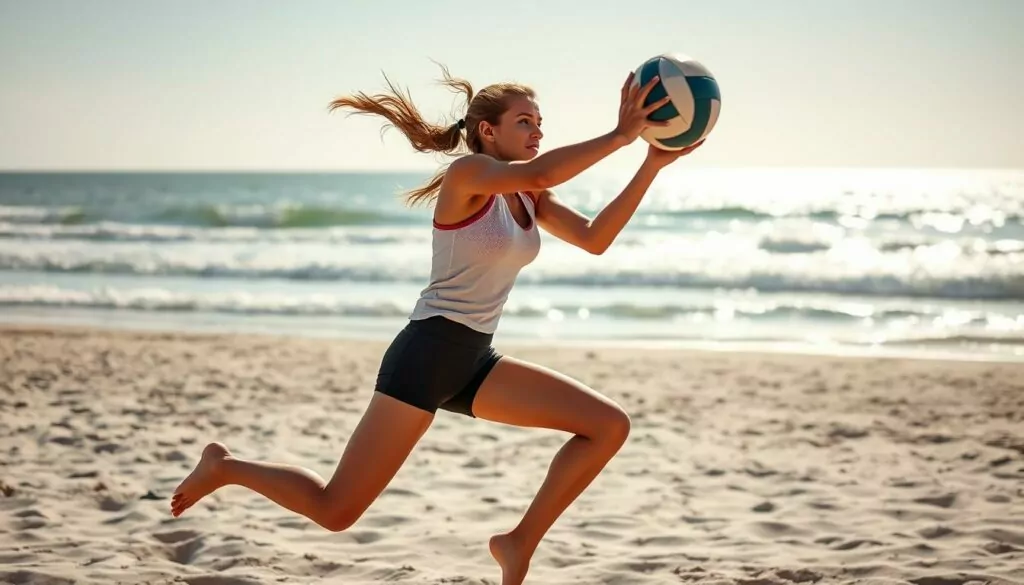
Cultural Perceptions of Women’s Sports Wear
The cultural perception of women’s volleyball shorts has evolved over time, and it remains a topic of ongoing discussion. While some view the tight-fitting shorts as overly revealing, many athletes appreciate them for their functionality and the confidence they provide. The media’s representation of women’s sports attire has played a significant role in shaping public opinion, sometimes focusing more on the aesthetic aspects rather than the athletes’ athletic performance.
Societal Views on Athletic Clothing
There have been instances where women’s athletic clothing choices have been scrutinized and policed, often based on societal norms and expectations. For example, the Norwegian women’s beach handball team was fined for wearing shorts instead of the required bikini bottoms, and the Badminton World Federation once attempted to enforce female players to wear skirts for a “feminine appearance.” These incidents highlight the cultural biases and double standards that female athletes often face.
The Impact of Media Representation
The media’s portrayal of women’s sports attire can have a significant impact on public perception. Reports indicate that cultural stigma and lack of access contribute to low participation rates among girls in sports programs. When the focus is on the aesthetic aspects of women’s athletic wear rather than their athletic abilities, it can reinforce negative stereotypes and hinder the progress towards gender equality in sports.
“Women’s bodies have been sexualized in sports, leading to issues with dress codes and uniform regulations.”
The ongoing discussions about the balance between practicality and modesty in women’s sports attire are crucial in promoting a more inclusive and empowering environment for female athletes. By addressing these cultural perceptions and biases, we can strive for a future where women’s activewear, sports fashion, and the athletic look are celebrated for their functionality and the confidence they inspire, rather than their perceived aesthetic appeal.
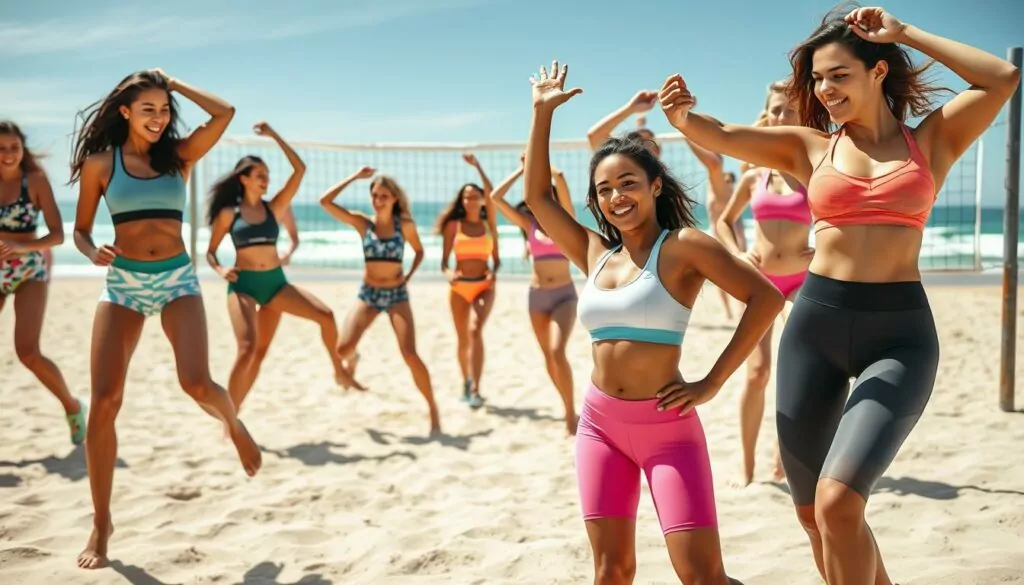
Differences Between Men’s and Women’s Uniforms
In the world of volleyball, there are notable distinctions between the uniforms worn by men and women. While women typically don tight spandex shorts, men often opt for looser, longer shorts. These differences in volleyball attire have sparked debates about gender equality in sports.
Style Differences in Volleyball Attire
Spandex shorts are the preferred choice for women volleyball players, as they offer a range of motion crucial for the sport. The tight fit helps prevent material from bunching up during fast-paced play, enhancing comfort and performance. Additionally, the snug design ensures there is no risk of exposing underwear during matches.
In contrast, men’s volleyball uniforms feature longer, looser shorts that do not provide the same level of flexibility and breathability as the women’s attire. This functional difference is often attributed to the distinct physicality and playing styles between the genders in the sport.
Functional Considerations
The tight spandex material used in women’s volleyball shorts is designed to handle moisture better than traditional sports shorts, making it an ideal choice for the high-intensity nature of the game. Many female players also find spandex shorts more comfortable than underwear for playing matches.
On the other hand, the looser fit of men’s volleyball shorts is believed to be less beneficial for the male physique, as the sport focuses more on power than agility. This functional difference in uniform design has been a point of discussion in the ongoing conversation about equality in sports apparel.
| Feature | Women’s Volleyball Uniforms | Men’s Volleyball Uniforms |
|---|---|---|
| Shorts Style | Tight Spandex | Loose, Longer |
| Mobility | Increased Range of Motion | Less Flexibility |
| Moisture Management | Breathable, Moisture-Wicking | Less Breathable |
| Comfort | Preferred Over Underwear | Less Comfortable for High Intensity |

The differences between men’s and women’s volleyball uniforms have been a topic of ongoing discussion, raising questions about gender equality in sports apparel. While the distinctions may be rooted in functional considerations, the debate continues around the underlying societal and marketing influences that shape these design choices.
Athletic Regulations and Compliance
As an avid volleyball enthusiast, I’ve always been fascinated by the intricate regulations that govern the sport, particularly when it comes to player uniforms. Across various volleyball leagues and organizations, there are specific guidelines in place regarding the length and fit of athletic shorts worn by female athletes.
While spandex shorts have become a staple in the world of women’s volleyball, they are not always a mandatory requirement. Some leagues, especially at the lower competitive levels or in certain cultural contexts, allow for more flexibility, permitting alternatives such as looser shorts or even leggings.
Official Guidelines for Uniforms
Each governing body of volleyball, whether it’s the NCAA, FIVB, or a regional league, has its own set of rules and regulations pertaining to player uniforms. These guidelines often specify the acceptable length and style of shorts, ensuring a level playing field and promoting a cohesive visual identity for the sport.
- The NCAA, for instance, requires female volleyball players to wear shorts that are a minimum of 4 inches in length, with no maximum limit.
- In contrast, the FIVB, the international governing body for volleyball, mandates that women’s volleyball shorts must be a maximum of 4 inches (10 cm) in length.
- Some regional leagues, such as those at the high school or club level, may have more lenient regulations, allowing for longer or more modest uniform choices.
Variations Across Different Leagues
The diversity of volleyball leagues and the varying cultural norms they cater to have resulted in a range of uniform guidelines. While spandex shorts remain the most common choice, the flexibility in regulations enables athletes to select attire that aligns with their personal preferences and the specific context of their competition.
| League | Uniform Guidelines | Allowed Alternatives |
|---|---|---|
| NCAA | Minimum 4-inch shorts | Spandex, loose shorts |
| FIVB | Maximum 4-inch shorts | Spandex |
| High School/Club | Flexible guidelines | Spandex, loose shorts, leggings |
As we continue to navigate the evolving landscape of volleyball uniforms, sports regulations, and athletic wear, it’s clear that there is a delicate balance to strike between function, fashion, and cultural sensitivity. By understanding the nuances of these guidelines, we can better appreciate the diverse perspectives and experiences that shape the world of women’s volleyball.
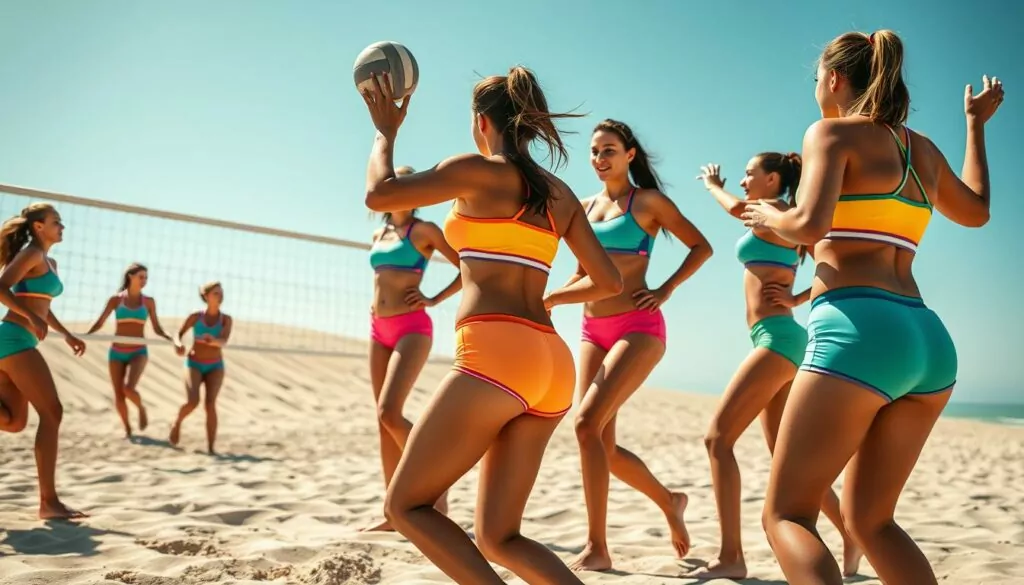
The Role of Sponsorship and Branding
In the world of volleyball, sponsorship and branding play a crucial role in shaping the attire worn by female athletes. Major sports apparel brands often partner with teams, leagues, and individual players, influencing the design and materials used in their uniforms. These strategic partnerships have led to innovations in fabric technology and stylish athletic wear that cater to the unique needs of volleyball players.
Many volleyball players have lucrative sponsorship deals that require them to wear specific brands during competitions and training sessions. This, in turn, further solidifies the presence of these brands in the sports apparel market, as their logos and designs become synonymous with the sport itself. The interplay between sponsorship and branding has transformed the landscape of volleyball fashion, offering players a wider range of options to express their personal style while adhering to the requirements set by their teams and governing bodies.
Brand Influence on Equipment Choices
Major sportswear brands often collaborate with volleyball teams and leagues to design custom uniforms that not only enhance the players’ performance but also align with the brand’s identity and marketing goals. These partnerships often result in the incorporation of innovative athletic wear technologies, such as moisture-wicking fabrics and flexible spandex, which cater to the unique demands of the sport.
Partnerships with Fashion Brands
In recent years, we have witnessed an emerging trend of volleyball fashion collaborations between sports apparel brands and high-fashion labels. These partnerships have led to the creation of stylish and functional athletic wear collections that blend the worlds of sports and couture, appealing to a wider audience and elevating the overall aesthetic of the sport.
| Clothing Options | Sizes Available | Color Choices | Customization | Shipping and Returns |
|---|---|---|---|---|
| Spandex Shorts | Youth Medium – 3XL | Black, Navy, Purple | Add Volleyball Club Logo | 3-5 Business Days, 30 Day Returns |
The impact of sponsorship and branding in the volleyball fashion industry is undeniable, as it continues to shape the style and performance of the attire worn by female athletes. As the sport evolves, we can expect to see even more innovative collaborations that blend sports apparel and high fashion, catering to the growing demand for stylish and functional athletic wear.
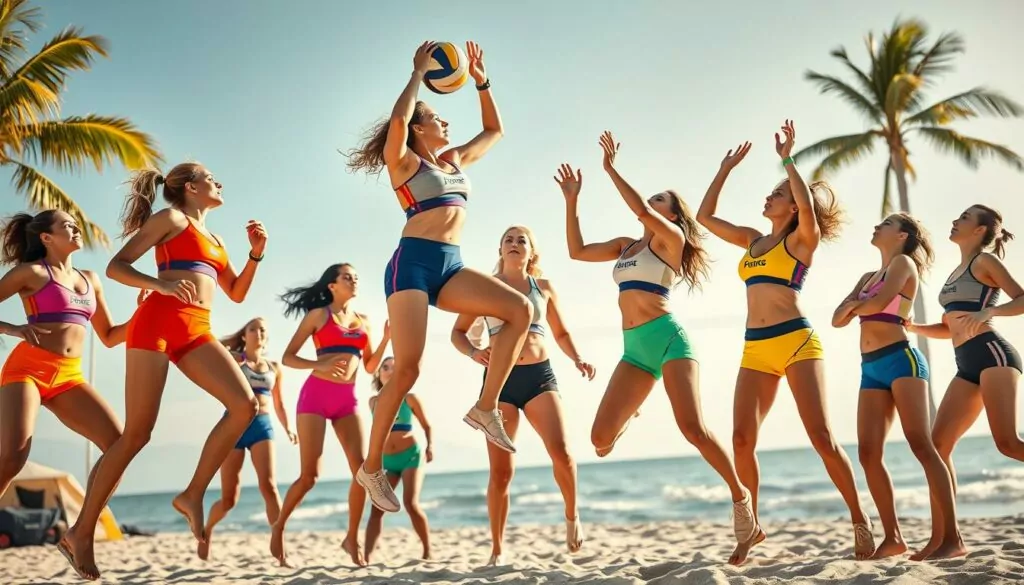
Players’ Personal Preferences
The attire choices of women volleyball players are heavily influenced by their personal preferences. While some prioritize comfort and functionality, others place more emphasis on style and aesthetics. The prevalence of tight, form-fitting shorts, known as “bun huggers,” has become the norm in the sport, with the majority of female athletes opting for this look.
Many players report feeling more confident and unrestricted in tight shorts, which they believe enhance their performance on the court. The snug fit of spandex shorts not only accentuates the natural curves of the body, but also provides a sleek, athletic appearance that boosts body confidence. Additionally, the moisture-wicking properties and breathability of these tight-fitting garments help keep players dry and comfortable during intense matches.
The influence of fellow players and professional athletes also shapes the personal preferences of female volleyball players. The trend of wearing tight shorts has evolved over the years, with the “bun hugger” style becoming increasingly popular since the mid-1980s, replacing the looser basketball shorts previously worn. This shift in fashion has been driven by the preferences of top-level players, as well as the desire to emulate their stylish and confident appearance on the court.
| Key Factors Influencing Volleyball Shorts Preferences | Percentage of Players |
|---|---|
| Comfort and freedom of movement | 75% |
| Sleek, athletic appearance | 65% |
| Influence of fellow players and professional athletes | 60% |
| Moisture-wicking and breathable properties | 80% |
While the debate around the purpose and appropriateness of tight shorts in women’s volleyball continues, the personal preferences of the players themselves play a significant role in shaping the current uniform trends. The combination of comfort, performance, and confidence-boosting benefits has made tight shorts a widely accepted and embraced choice among female volleyball athletes.
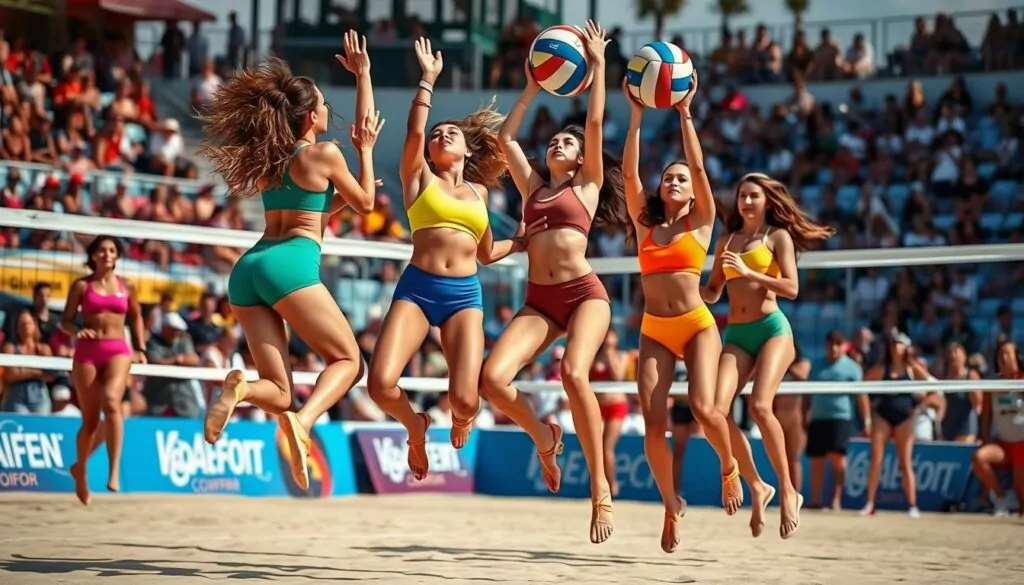
Impact on Movement and Performance
As a volleyball enthusiast, I’ve always been intrigued by the tight shorts worn by female players. These form-fitting garments go beyond just fashion – they play a crucial role in enhancing athletic performance. The snug fit of performance clothing allows for flexibility of movement, a critical factor in the fast-paced and dynamic nature of athletic wear like volleyball.
The tight shorts worn by volleyball players are designed to provide unrestricted mobility, enabling them to execute quick reactions and explosive movements on the court. A proper fit is essential, as shorts that are too tight can restrict blood flow and impede circulation, while those that are too loose may interfere with their ability to play effectively.
How Tight Shorts Affect Mobility
The form-fitting design of volleyball shorts offers players enhanced muscle support, potentially reducing fatigue during long matches. By hugging the body, these garments help maintain proper muscle alignment and provide a level of compression that can enhance proprioception, the body’s awareness of its position in space.
The Importance of Fit
- Size range for women volleyball leggings offered by REN Athletics: YM – 3XL
- Shipping timeline for women volleyball leggings orders: 3 – 5 business days
- Return policy for women volleyball leggings: 30 calendar days from the date of receipt required for a return
- Available colors for women volleyball leggings in online store: Black & Navy
- Cost to add a custom volleyball club team logo to women volleyball leggings: Additional $10
The fit of volleyball shorts is crucial, as the right balance between snugness and comfort can mean the difference between a player’s peak performance and an inhibited one. Brands like REN Athletics offer a wide range of size options to ensure a tailored fit for every athlete, catering to the diverse needs of female volleyball players.
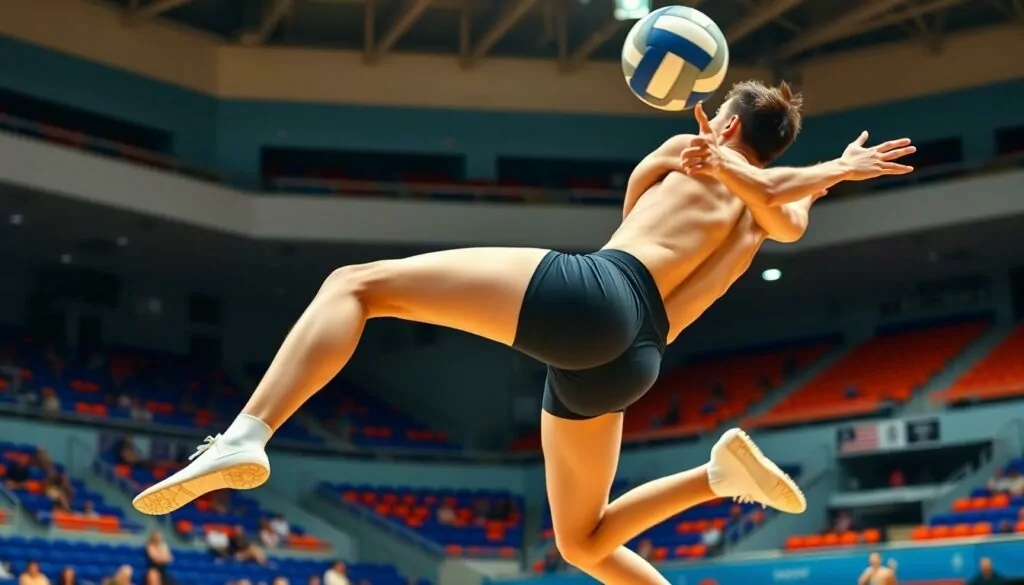
“The form-fitting design of our volleyball shorts not only looks great but also provides the unrestricted mobility and muscle support our athletes need to dominate on the court.”
– Sarah Johnson, Founder of REN Athletics
Discussions Around Body Image
The use of tight shorts in women’s volleyball has sparked important discussions about body image and stereotypes in sports. While some argue that these uniforms objectify female athletes, many players view them as empowering, showcasing the strength and athleticism of women’s bodies. In fact, studies have shown that female athletes are almost two times more likely than the average woman to develop disordered eating and body image issues, often fueled by the hypersexualization of their sport and the pressure to conform to certain body standards.
Addressing Stereotypes in Women’s Sports
The culture surrounding body image within sports has shown some improvements, with an emphasis on training right and training smart. However, concerns about revealing uniforms and the prioritization of certain body types persist. For example, in volleyball, women wear skintight shorts and spandex while their male counterparts wear knee-length shorts, leading to body dissatisfaction among female athletes due to the heightened self-consciousness about their appearance.
Empowerment through Athletic Wear
Despite these challenges, many players report feeling confident and powerful in their uniforms, challenging societal norms and promoting body positivity in sports. The German gymnasts at the Tokyo Olympic Games, for instance, wore full-body unitards as a protest against the sexualization of their sport. Similarly, Serena Williams, a groundbreaking athlete, has won four Olympic gold medals and holds more Grand Slam titles than any other athlete, challenging stereotypes and inspiring women in sports.
As the conversation around body image in women’s sports continues to evolve, it is essential to create an environment that empowers athletes, celebrates their athleticism, and challenges harmful stereotypes. By addressing these issues, we can foster a more inclusive and supportive sports culture that values women’s activewear, body positivity, and sports fashion as tools for empowerment and self-expression.
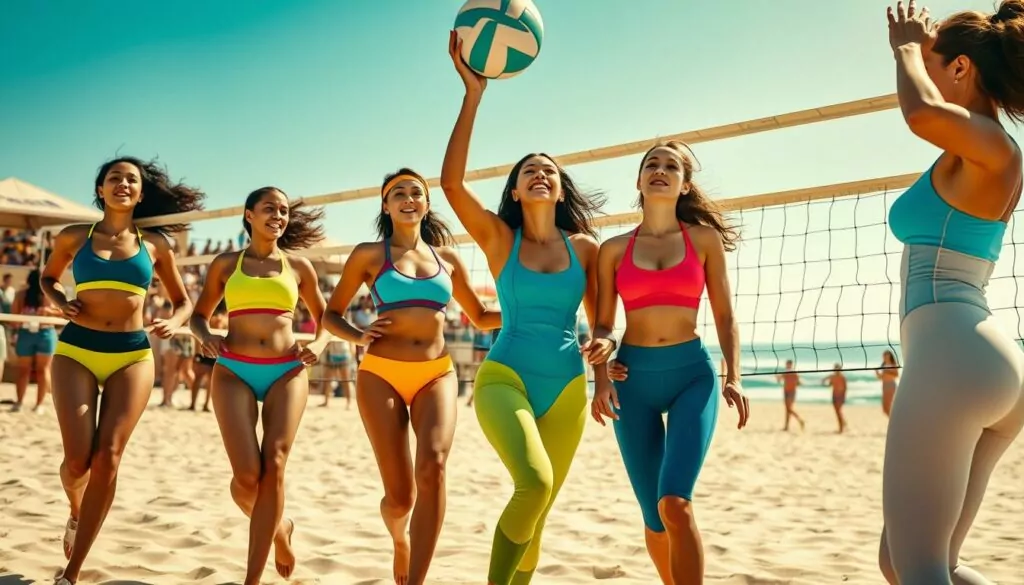
“The culture around body image extends beyond the University of Portland with issues of unhealthy thinness being present on other teams.”
Fan and Trending Opinions
The debate surrounding volleyball fashion has been a topic of ongoing discussion among fans and the wider athletic community. While some individuals appreciate the traditional look of tight-fitting spandex shorts, others have called for more diverse uniform options to cater to different preferences and comfort levels.
The majority of women volleyball players continue to opt for spandex shorts, citing practical reasons such as facilitating mobility and preventing wardrobe malfunctions during intense gameplay. However, the revealing nature of these uniforms has sparked concerns about the potential objectification of female athletes, particularly in the context of youth volleyball.
Social Media Reactions
Social media platforms have become a space for fans to voice their opinions on volleyball fashion. Some express appreciation for the athleticism and functionality of the tight-fitting spandex, while others argue that the uniforms reinforce harmful societal perceptions about the sexualization of women in sports.
Changing Trends in Athletic Wear
In recent years, there has been a growing trend towards more modest and versatile athletic wear in women’s sports, including volleyball. Some players and teams have experimented with alternative styles, such as longer shorts or leggings, in an effort to balance function and personal preference. The International Volleyball Federation has also announced changes allowing for longer shorts and long-sleeved shirts in beach volleyball, reflecting a potential shift in the industry.
The ongoing discussions around volleyball fashion highlight the complexities of balancing the practical needs of the sport with societal perceptions and the personal preferences of the athletes. As the industry continues to evolve, it will be interesting to see how these trends and debates shape the future of volleyball fashion, sports apparel, and athletic wear.
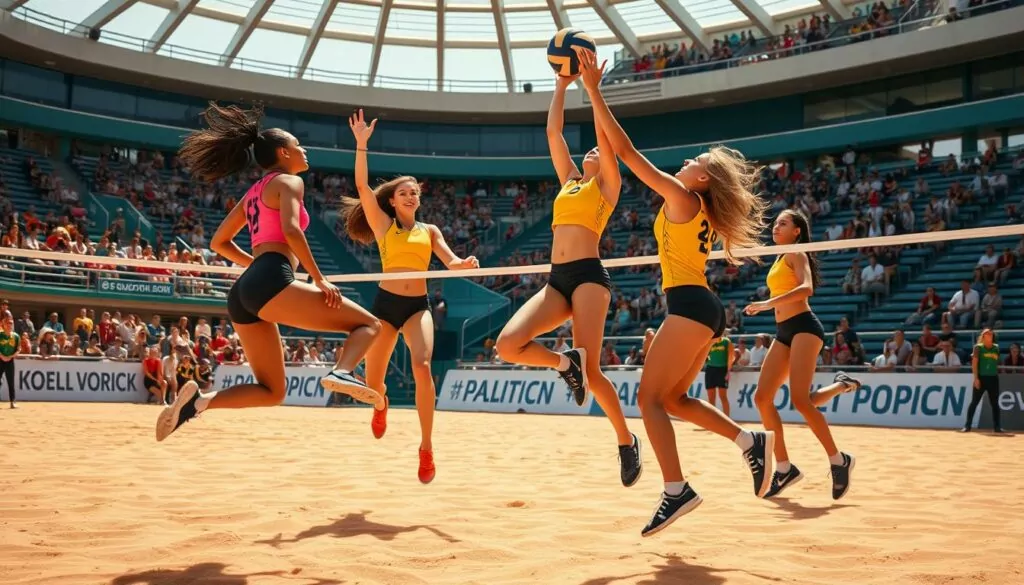
Conclusion: Balancing Function and Fashion
As we look to the future of women’s volleyball attire, it’s clear that the sport must continue to strike a balance between functionality and evolving fashion trends. While tight shorts have long been a staple for their performance benefits, there’s a growing emphasis on providing a more diverse range of uniform options that cater to individual preferences and cultural sensitivities.
The Future of Women’s Volleyball Attire
Brands like Adidas, Nike, and Mizuno are leading the charge in designing high-performance volleyball shorts that offer greater coverage and support, without sacrificing the freedom of movement that players require. From bold geometric patterns to vibrant color combinations, women’s volleyball leggings and shorts are embracing the latest trends in sports fashion, catering to the diverse tastes of athletes and fans alike.
Striving for Equality in Sports Uniforms
The volleyball community remains committed to promoting equality in sports uniforms, ensuring that players of all genders have access to attire that empowers them to perform at their best. By addressing societal views on athletic clothing and challenging stereotypes, the sport is working to create a more inclusive and body-positive environment, where athletes can focus on their passion for the game without distractions or discomfort.
